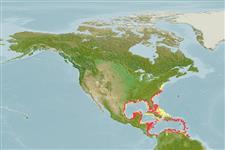>
Syngnathiformes (Pipefishes and seahorses) >
Syngnathidae (Pipefishes and seahorses) > Syngnathinae
Etymology: Syngnathus: Greek, syn, symphysis = grown together + Greek, gnathos = jaw (Ref. 45335).
More on authors: Jordan & Gilbert.
Environment: milieu / climate zone / depth range / distribution range
Ecologie
marien demersaal; diepte 18 - 55 m (Ref. 126547), usually ? - 5 m (Ref. 126547). Subtropical; 40°N - 8°N
Western Atlantic: disjunct distribution from Bermuda and Chesapeake Bay (USA), including the northern Gulf of Mexico, the Bahamas, and the western Caribbean Sea (Ref. 37039), to Panama.
Grootte / Gewicht / Leeftijd
Maturity: Lm ? range ? - ? cm
Max length : 26.0 cm TL mannelijk / geslacht onbekend; (Ref. 27549)
Korte beschrijving
Morfologie | Morfometrie
Dorsale zachte stralen (totaal): 26-35. Preorbital bone appears as broad plate in front of eye (Ref. 26938).
Abundant in seagrass beds along coasts. Northern populations move offshore during colder months (Ref. 26938). Found mostly at 5 m or less (Ref. 126547). Ovoviviparous (Ref. 205). The male carries the eggs in a brood pouch which is found under the tail (Ref. 205). Feeds mostly on small grass shrimp and other small crustaceans (Ref. 93252).
Levenscyclus en paargedrag
Maturiteit | Voortplanting | Paaien | Eieren | Fecunditeit | Larven
Male carries the eggs in a brood pouch (Ref. 205, 53335).
Robins, C.R. and G.C. Ray, 1986. A field guide to Atlantic coast fishes of North America. Houghton Mifflin Company, Boston, U.S.A. 354 p. (Ref. 7251)
Status op de Rode Lijst van het IUCN (Ref. 130435)
Gevaar voor de mens
Harmless
Gebruik door de mens
Meer informatie
Leeftijd/GrootteGroeiLengte-gewichtLengte-lengteLengtefrequentiesMorfometrieMorfologieLarvenLarvale populatiedynamiekRekruteringAbundantieBRUVS
ReferentiesAquacultuurAquacultuurprofielKweeklijnenGeneticaElectrophoresesErfelijkheidZiektesVerwerkingNutrientsMassaconversie
Tools
Speciale rapporten
Download XML
Internetbronnen
Estimates based on models
Preferred temperature (Ref.
123201): 23.5 - 28.2, mean 27.1 °C (based on 614 cells).
Fylogenetische diversiteitsindex (Ref.
82804): PD
50 = 0.5000 [Uniqueness, from 0.5 = low to 2.0 = high].
Bayesian length-weight: a=0.00028 (0.00012 - 0.00065), b=3.21 (3.03 - 3.39), in cm total length, based on LWR estimates for this Genus-body shape (Ref.
93245).
Trofisch niveau (Ref.
69278): 3.3 ±0.45 se; based on food items.
Weerstandsvermogen (Ref.
120179): Hoog, minimale populatieverdubbelingstijd minder dan 15 maanden (Preliminary K or Fecundity.).
Fishing Vulnerability (Ref.
59153): Low vulnerability (16 of 100).
